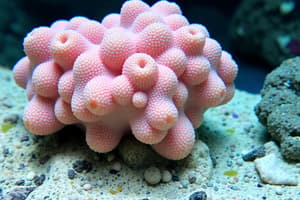Podcast
Questions and Answers
What is the primary function of the water transport system in sponges?
What is the primary function of the water transport system in sponges?
- It facilitates excretion only.
- It serves as a reproductive structure.
- It aids in locomotion and movement.
- It enables food gathering, respiratory exchange, and waste removal. (correct)
What is true about the reproductive strategy of sponges?
What is true about the reproductive strategy of sponges?
- Eggs and sperms are produced by separate individuals.
- They are hermaphrodites producing both eggs and sperms. (correct)
- They undergo external fertilization in most cases.
- They exclusively reproduce asexually.
How is digestion achieved in sponges?
How is digestion achieved in sponges?
- By a process of diffusion through the body wall.
- By utilizing specialized stomach chambers.
- Through external digestion followed by absorption.
- Via intracellular digestion performed by choanocytes. (correct)
What structure lines the spongocoel in sponges?
What structure lines the spongocoel in sponges?
Which feature of sponges contributes to their primitive multicellular organization?
Which feature of sponges contributes to their primitive multicellular organization?
What type of skeleton do sponges possess?
What type of skeleton do sponges possess?
What is the structural feature that allows water to enter the body of sponges?
What is the structural feature that allows water to enter the body of sponges?
What is the developmental characteristic of sponges?
What is the developmental characteristic of sponges?
Which of the following statements is true regarding sponge reproduction?
Which of the following statements is true regarding sponge reproduction?
What type of cellular organization characterizes sponges?
What type of cellular organization characterizes sponges?
Which components provide structural support to a sponge's body?
Which components provide structural support to a sponge's body?
Flashcards are hidden until you start studying
Study Notes
Overview of Phylum Porifera
- Commonly known as sponges, members of Phylum Porifera are primarily marine and exhibit asymmetry.
- Represent primitive multicellular organisms with a cellular level of organization.
Water Transport System
- Possess a unique canal system that facilitates water movement through the body.
- Water enters through minute openings called ostia, flows into a central cavity known as the spongocoel, and exits through the osculum.
- This water transport system aids in:
- Food gathering
- Respiratory exchange
- Waste removal
Cellular Structure and Digestion
- The internal surface of the spongocoel and canals is lined with choanocytes (collar cells).
- Digestion occurs intracellularly, meaning digestion takes place within the cells.
Support and Skeleton
- Sponges have a supportive skeleton made of spicules (microscopic structures) or spongin fibers.
Reproductive Characteristics
- Sponges are hermaphroditic, producing both eggs and sperm within the same individual.
- Reproduction occurs:
- Asexually by fragmentation (breaking apart and regeneration).
- Sexually through the formation of gametes, with internal fertilization.
- Development is indirect, involving a larval stage that is structurally different from the adult form.
Overview of Phylum Porifera
- Commonly known as sponges, members of Phylum Porifera are primarily marine and exhibit asymmetry.
- Represent primitive multicellular organisms with a cellular level of organization.
Water Transport System
- Possess a unique canal system that facilitates water movement through the body.
- Water enters through minute openings called ostia, flows into a central cavity known as the spongocoel, and exits through the osculum.
- This water transport system aids in:
- Food gathering
- Respiratory exchange
- Waste removal
Cellular Structure and Digestion
- The internal surface of the spongocoel and canals is lined with choanocytes (collar cells).
- Digestion occurs intracellularly, meaning digestion takes place within the cells.
Support and Skeleton
- Sponges have a supportive skeleton made of spicules (microscopic structures) or spongin fibers.
Reproductive Characteristics
- Sponges are hermaphroditic, producing both eggs and sperm within the same individual.
- Reproduction occurs:
- Asexually by fragmentation (breaking apart and regeneration).
- Sexually through the formation of gametes, with internal fertilization.
- Development is indirect, involving a larval stage that is structurally different from the adult form.
Studying That Suits You
Use AI to generate personalized quizzes and flashcards to suit your learning preferences.




